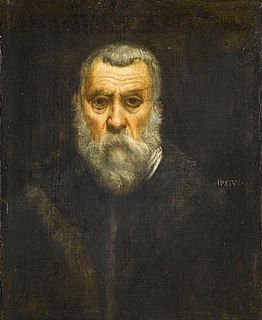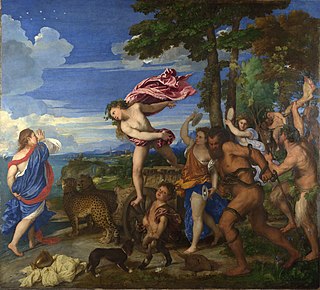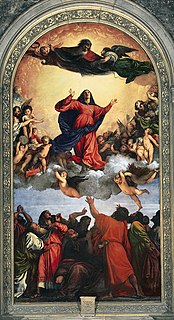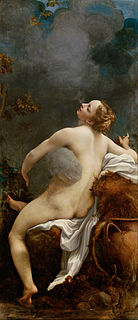Related Research Articles

Giorgione was an Italian painter of the Venetian school during the High Renaissance, who died in his thirties. He is known for the elusive poetic quality of his work, though only about six surviving paintings are firmly attributed to him. The uncertainty surrounding the identity and meaning of his work has made Giorgione one of the most mysterious figures in European art.

Tiziano Vecelli or Vecellio, known in English as Titian, was an Italian (Venetian) painter during the Renaissance, considered the most important member of the 16th-century Venetian school. He was born in Pieve di Cadore, near Belluno. During his lifetime he was often called da Cadore, 'from Cadore', taken from his native region.

Giovanni Bellini was an Italian Renaissance painter, probably the best known of the Bellini family of Venetian painters. He was raised in the household of Jacopo Bellini, formerly thought to have been his father, but now that familial generational relationship is questioned. An older brother, Gentile Bellini was more highly regarded than Giovanni during his lifetime, although the reverse is true today. His brother-in-law was Andrea Mantegna.

Paolo Cagliari, known as Paolo Veronese, was an Italian Renaissance painter based in Venice, known for extremely large history paintings of religion and mythology, such as The Wedding at Cana (1563) and The Feast in the House of Levi (1573). Included with Titian, a generation older, and Tintoretto, a decade senior, Veronese is one of the "great trio that dominated Venetian painting of the cinquecento" and the Late Renaissance in the 16th century. Known as a supreme colorist, and after an early period with Mannerism, Paolo Veronese developed a naturalist style of painting, influenced by Titian.

Tintoretto was an Italian painter identified with the Venetian school. His contemporaries both admired and criticized the speed with which he painted, and the unprecedented boldness of his brushwork. For his phenomenal energy in painting he was termed Il Furioso. His work is characterised by his muscular figures, dramatic gestures and bold use of perspective, in the Mannerist style.

Bacchus and Ariadne (1522–1523) is an oil painting by Titian. It is one of a cycle of paintings on mythological subjects produced for Alfonso I d'Este, Duke of Ferrara, for the Camerino d'Alabastro – a private room in his palazzo in Ferrara decorated with paintings based on classical texts. An advance payment was given to Raphael, who originally held the commission for the subject of a Triumph of Bacchus. At the time of Raphael's death in 1520, only a preliminary drawing was completed and the commission was then handed to Titian. In the case of Bacchus and Ariadne, the subject matter was derived from the Roman poets Catullus and Ovid.

The Assumption of the Virgin or Frari Assumption, popularly known as the Assunta, is a large altarpiece panel painting in oils by the Italian Renaissance artist Titian, painted in 1515–1518. It remains in the position it was designed for, on the high altar of the Basilica di Santa Maria Gloriosa dei Frari or Frari church in Venice. It is the largest altarpiece in the city, with the figures well over life-size, necessitated by the large church, with a considerable distance between the altar and the congregation. The images above and below are not Titian's work, they are by Palma Vecchio. It marked a new direction in Titian's style, that reflected his awareness of the developments in High Renaissance painting further south, in Florence and Rome, by artists including Raphael and Michelangelo. The agitated figures of the Apostles marked a break with the usual meditative stillness of saints in Venetian painting, in the tradition of Giovanni Bellini and others.

Italian Renaissance painting is the painting of the period beginning in the late 13th century and flourishing from the early 15th to late 16th centuries, occurring in the Italian Peninsula, which was at that time divided into many political states, some independent but others controlled by external powers. The painters of Renaissance Italy, although often attached to particular courts and with loyalties to particular towns, nonetheless wandered the length and breadth of Italy, often occupying a diplomatic status and disseminating artistic and philosophical ideas.

Diana and Actaeon is a painting by the Italian Renaissance master Titian, finished in 1556–1559, and is considered amongst Titian's greatest works. It portrays the moment in which the hunter Actaeon bursts in where the goddess Diana and her nymphs are bathing. Diana is furious, and will turn Actaeon into a stag, who is then pursued and killed by his own hounds, a scene Titian later painted in his The Death of Actaeon.

The Orleans Collection was a very important collection of over 500 paintings formed by Philippe d'Orléans, Duke of Orléans, mostly acquired between about 1700 and his death in 1723. Apart from the great royal-become-national collections of Europe it is arguably the greatest private collection of Western art, especially Italian, ever assembled, and probably the most famous, helped by the fact that most of the collection has been accessible to the public since it was formed, whether in Paris, or subsequently in London, Edinburgh and elsewhere.

The Eleven Caesars was a series of eleven painted half-length portraits of Roman emperors made by Titian in 1536-40 for Federico II, Duke of Mantua. They were among his best-known works, inspired by the Lives of the Caesars by Suetonius. Titian's paintings were originally housed in a new room inside the Palazzo Ducale di Mantova. Bernardino Campi added a twelfth portrait in 1562.

Sir Peter Paul Rubens was a Flemish artist and diplomat from the Duchy of Brabant in the Southern Netherlands. He is considered the most influential artist of the Flemish Baroque tradition. Rubens's highly charged compositions reference erudite aspects of classical and Christian history. His unique and immensely popular Baroque style emphasized movement, colour, and sensuality, which followed the immediate, dramatic artistic style promoted in the Counter-Reformation. Rubens was a painter producing altarpieces, portraits, landscapes, and history paintings of mythological and allegorical subjects. He was also a prolific designer of cartoons for the Flemish tapestry workshops and of frontispieces for the publishers in Antwerp.

Palma Vecchio, born Jacopo Palma and also known as Jacopo Negretti, was a Venetian painter of the Italian High Renaissance. He was born at Serina Alta near Bergamo, a dependency of the Republic of Venice, but his recorded career all took place in or near Venice. He is called Palma Vecchio in English to distinguish him from Palma il Giovane, his great-nephew, who was also a painter.

Venetian painting was a major force in Italian Renaissance painting and beyond. Beginning with the work of Giovanni Bellini and his brother Gentile Bellini and their workshops, the major artists of the Venetian school included Giorgione, Titian, Tintoretto (1518–1594), Paolo Veronese (1528–1588) and Jacopo Bassano (1510–1592) and his sons. Considered to give primacy to colour over line, the tradition of the Venetian school contrasted with the Mannerism prevalent in the rest of Italy. The Venetian style exerted great influence upon the subsequent development of Western painting.

Danaë is a series of at least six versions of the same composition by Italian painter Titian and his workshop made between about 1544 and the 1560s. The scene is based on the mythological princess Danaë, as – very briefly – recounted by the Roman poet Ovid, and at greater length by Boccaccio. She was isolated in a bronze tower following a prophecy that her firstborn would eventually kill her father. Although aware of the consequences, Danaë was seduced and became pregnant by Zeus, who, inflamed by lust, descended from Mount Olympus to seduce her in the form of a shower of gold.

The Madonna and Child with Saints Luke and Catherine of Alexandria, also known simply as Holy Conversation, is a painting by the Italian Renaissance master Titian. It is one of his several versions of the canonical image of the Madonna and Child.

The Equestrian Portrait of Charles I is a large oil painting on canvas by Anthony van Dyck, showing Charles I on horseback. Charles I had become King of England, Scotland and Ireland in 1625 on the death of his father James I, and Van Dyck became Charles's Principal Painter in Ordinary in 1632.

The Three Ages of Man is a painting by Titian, dated between 1512 and 1514, and now displayed at the Scottish National Gallery in Edinburgh. The 90 cm high by 151 cm wide Renaissance art work was most likely influenced by Giorgione's themes and motifs of landscapes and nude figures—Titian was known to have completed some of Giorgione's unfinished works after Giorgione died at age 33 of the plague in 1510. The painting represents the artist's conception of the life cycle. Childhood and manhood are synonymous with earthly love and death approaching old age are drawn realistically. Titian's widely chosen topic in art history, ages of man, mixed with his own allegorical interpretation make The Three Ages of Man one of Titian's most famous works.

Tarquin and Lucretia is an oil painting by Titian completed in 1571, when the artist was in his eighties, for Philip II of Spain. It is signed, and considered to have been finished entirely by Titian himself. It is one of a series of great works from Titian's last years, but unlike some of these, is fully finished. It is now in the Fitzwilliam Museum in Cambridge, England.

Woman with a Mirror is a painting by Titian, dated to c. 1515 and now in the Musée du Louvre.
References
- ↑ Le maraviglie dell'arte: ovvero Le vite degli illustri pittori, Volume 1, by Carlo Ridolfi, Giuseppe Vedova, page 288-289.
- ↑ Storia della pittura italiana By Étienne Huard, page 163.
- ↑ Huard misspells name as Nadaldino.